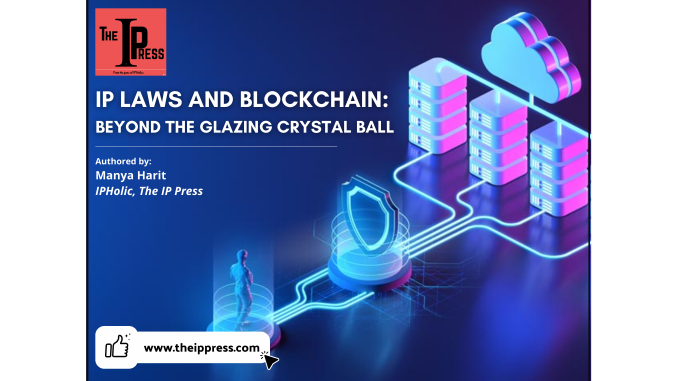
Blockchain is a modern evolving technology that tends to create a transparent platform to serve the purpose of transferring information which could be a fast, efficient, and cost-effective method, thus giving an opportunity for reforming a more accurate and safe chain of registration of IP rights.
It is also known as Distributed Ledger Technology (DLT) which is essentially a database of information focusing on designing a transparent and unalterable platform. The chain updates on the previous data so the information blocks can build on each other to form a chronological activity for a specific blockchain. Once it is stored in the database, the activity can’t be removed.
Blockchain & Intellectual Property
The nature of blockchain helps to ensure that data hasn’t been tampered giving a new dimension to intellectual property protection. By employing this technology, the efficiency and authenticity of establishing ownership rights, licensing through smart contracts, and registration of trademarks would improve remarkably.
By establishing clear ownership rights, any individual pursuing artistic endeavors can get a clear timestamp of his/her own work and prove infringement in a strategic manner. Similarly, the idea of eliminating third parties by enabling computer-coded, self-executing contracts with cryptographic signatures through this technology sounds promising.
Many instances are present where courts have considered blockchain as proof of evidence. In June of 2018 Hangzhou Internet Court admitted blockchain as evidence in a copyright case where the plaintiff used a third-party blockchain deposition service in order to secure online webpage evidence of the alleged copyright infringement.
In India, for the purpose of controlling transactions over blockchain networks, section 65B of The Indian Evidence Act, 1872 may be of vital importance.
As cyber security has been at risk, while private networks can be used to host IoT devices (Internet of Things) to provide security, the application of blockchain technology would add an extra layer of protection as intellectual property data would be safe even if the system falls.
The Flip side of the coin
With the fast-evolving technology, certain issues and challenges are there that are needed to be entertained. For instance, the complexity of the technology, promises of disruptive changes, and negative publicity of cryptocurrencies might reduce the acceptance rate among users.
In context to IP laws and the use of blockchain, the major issue is where the data will be stored- “on chain or off chain” meaning will it be stored on the chain itself or use third party storing services and eventually, who would be responsible for the wrong data stored. Lately, the argument regarding time stamping contracts has also been regarded as “off-chain”.
It might also disrupt pre-existing creative distribution networks with the increased copyright ownership and how the end user market would react to such changes. It ultimately raises questions regarding its implementation and market acceptance.
Intellectual property has been introduced to prevent the illegal distribution of creative works because of its easy mechanical, technological and digital reproduction nature. Extensive research has been conducted on management rights, digital rights management, and technological rights measures. The research clearly indicates problems with blockchain in specific areas of smart contracts, private ordering, copyright registries, and the legal framework of digital rights management along with the same remuneration that is needed to be looked into and worked upon. IP protection-based blockchain lacks legal support. It also lacks centralized management because the data can be distributed all across the world without any supervision, control or no legal backing. It is evident that present laws need to examine the impact of blockchain and the current legal requirements to match it.
Solution for blockchain-based IP protection
Various blockchain-based systems are available to solve the problems mentioned above. In order to prevent software hacking, a platform called ReSOLV enables software developers to protect copyright claims. A DRM chain is a system that stores copyright information enabling remuneration for authors in the form of digital currency. Finally, Panescu and Manta can be used for handling smart contracts by collecting original work.
The Way Forward
The idea of creating a more efficient blockchain managing system is still new; more work is needed to improve the problems that are still required to be addressed, like its compatibility, data issues, privacy concerns, complexity, etc which can impact essential rights in the modern digital environment.
Although several promising platforms are present trying to solve the issues in hand, still more work is needed to be done in this sector so that the technology can be efficiently used to replace the existing system.
REFRENCES
- https://core.ac.uk/download/pdf/301385106.pdf
- https://dai-global-digital.com/is-intellectual-property-ready-for-blockchain.html
- https://www.lexology.com/library/detail.aspx?g=512ab4b1-d234-4962-a4ff-0f4836618db9
Manya Harit
Author
Manya Harit is a 2nd-year law student pursuing B.A. LL.B, from Chaudhary Charan Singh University, Meerut. She is interested in International Arbitration, Intellectual Property, and Technology Law. She is an explorer and loves to work in a productive and creative atmosphere. Her LinkedIn Id is https://www.linkedin.com/in/manya-harit-08958a202
Leave a Reply